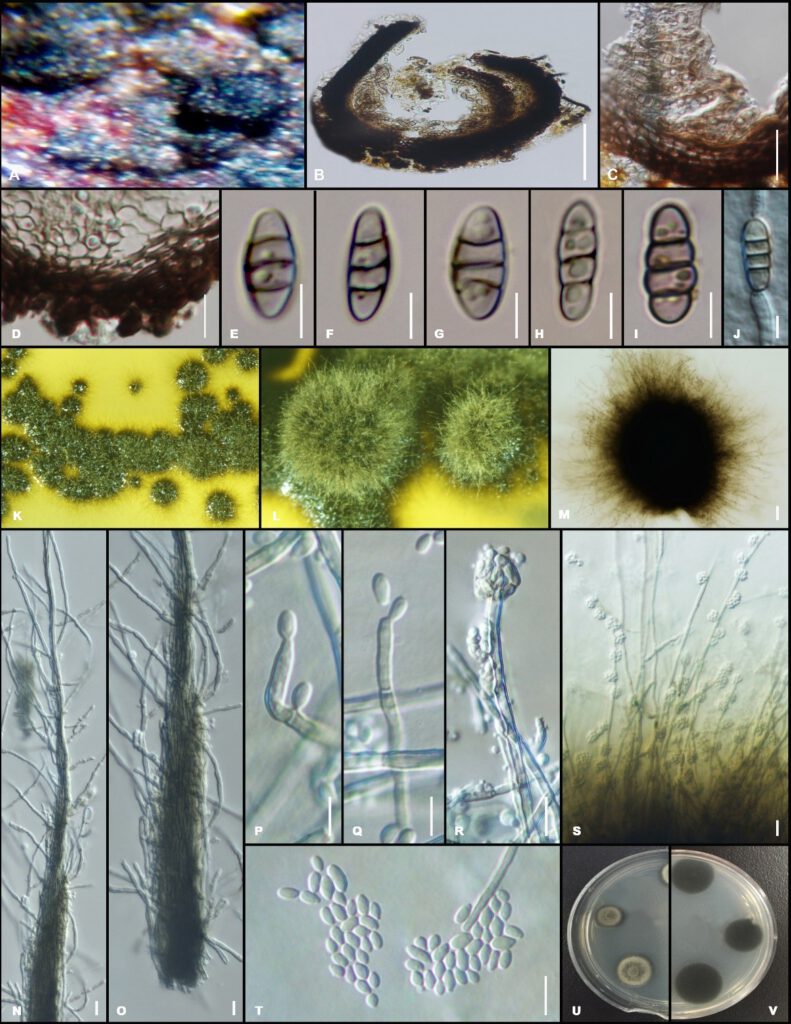Capronia lijiangensis M. Raza & L. Cai, sp. nov.
MycoBank number: MB 558077; Index Fungorum number: IF 558077; Facesoffungi number: FoF 10531;
Etymology: refers to Lijiang city in China from where it was isolated.
Holotype: HMAS 350625
Saprobic on wood. Sexual morph: Ascomata 105–145 μm high, 110–175 μm diam, stromatic, solitary or scattered in small groups, immersed, uni-loculate, individual or aggregated, black, with globose to subglobose, ostiole. Peridium 15–40 μm wide, comprising several layers; outer layers thick-walled, dark brown cells of textura globulosa; inner layers of thin-walled composed of textura paraismatica, lightly pigmented or hyaline cells. Ascospores 9.5–15 × 3.5–5 μm (x̅ = 11.97 ± 1.13 × 4.06 ± 0.39 μm, n = 40), initially light brown, becoming reddish-brown to brown, oblong to ellipsoidal, or subclavate with truncate base, 3-septate, not constricted at the septa, smooth-walled. Asexual morph: Hyphea smooth-walled, hyaline, septate, branched, 1.5–2.5 μm diam. Conidiomata acervular, erumpent, confluent, subglobose, up to 175 μm diam, conidiophores and setae formed on the cushion of rounded to angular brown cells. Setae pale to dark brown, 110–180 μm long, base cylindrical, tip obtuse to acute. Conidiophores aggregated, septate, branched, smooth or verruculose, 50–105 × 1.5–2 μm (x̅ = 78.87 ± 18.38 × 1.58 ± 0.23 μm, n =10). Conidiogenous cells terminal, subcylindrical, determinate, discrete, hyaline, smooth or verruculose, 4.5–8.5 × 1.5–2.8 μm (x̅ = 7.16 ± 1.44 × 1.87 ± 0.39 μm, n =15). Conidia one-celled, subhyaline to pale olivaceous, smooth, subglobose to ellipsoidal, 1.5–3.8 × 1–1.7 μm (x̅ = 2.34 ± 0.37 × 1.32 ± 0.14 μm, n =60).
Culture characteristics: Colonies on PDA reaching 40–45 mm diam. after 4 weeks at 25±2 °C, slow growing, colonies circular, umbonate, dull to rough with entire edge, sparse; colony from above: whitish to nyanza; From below, black; not producing pigment in PDA media.
Material examined: China, Yunnan Province, Lijiang City, on dead wood, July 2015, M. Raza (HMAS 350625, holotype); ex-holotype living culture CGMCC 3.20501 = LC15700.
Notes: Capronia lijiangensis formed a well-suported sister clade to C. camelliae-yunnanensis and C. pilosella (Fig. 10). Capronia lijiangensis differs by 18 bases in the ITS region, 3 bases in the LSU gene and 2 bases in the SSU gene compared to C. camelliae-yunnanensis. It differs from C. pilosella by 6 bases in the LSU and 1 base in the SSU markers. Capronia lijiangensis produces wider and shorter conidia compared to those in C. pilosella (9.5–15 × 3.5–5 μm vs. 7.5–17 × 2.5–4 μm) (Müller et al. 1987) while C. camelliae-yunnanensis was described in the telomorphic stage (Phookamsak et al. 2019). Capronia lijiangensis is the first species in Capronia known to have both sexual and asexual morphs, but asci were not observed due to limited and dried ascomata on its natural substrate.

Fig. x. Capronia lijiangensis (HMAS 350625, holotype). a Blackish ascomata on host. b Cross section of ascomata. c-d Peridium structure. e-i Conida. j Germinating conidium. k Conidiomata on PDA. l Mature conidiomata on PDA, top view. m Conidiomata mounted in lactic acid. n Tip of setae. o Base of setae. p-q Conidiogenous cell and conidia. r-s Conidiophores. t Conidia. u-v Culture characteristics on PDA (u from above, v from below). Scale bars: b = 50 μm, c-d = 10 μm, e-j, m-t = 5 μm.
